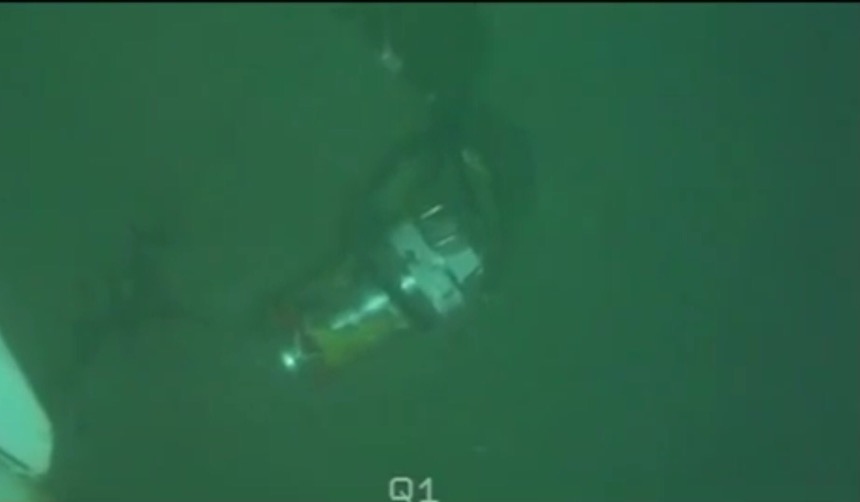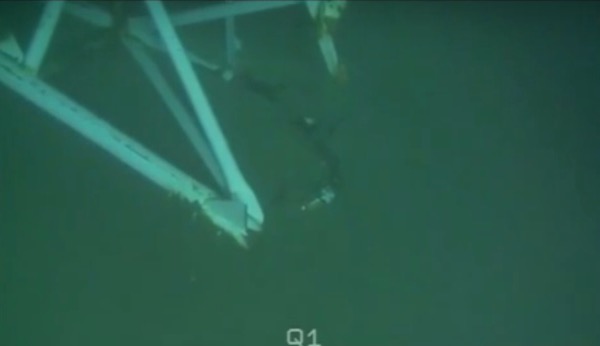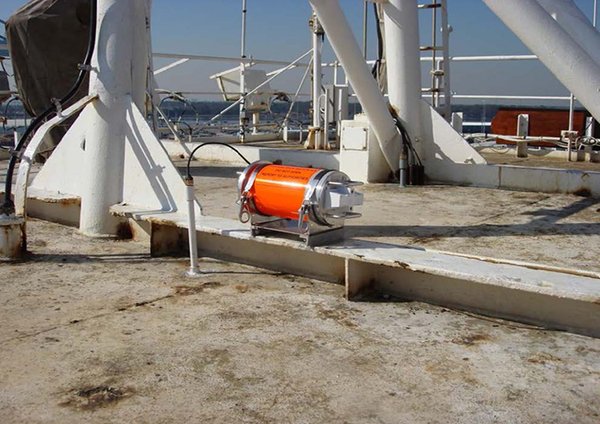Let’s see what happens next.
I hope they’re able to recover worthwhile information. I can only imagine how hard this will be on the families of the crew.
My name is Matthew K. Smith and I am a student at The State University of New York (SUNY) Maritime College. I am currently in my sophomore year studying International Transportation and Trade. The El Faro case is one that I am researching for a school project and I was wondering if anybody can get me up to speed with this conversation topic pertaining to the El Faro Data Recorder finding. I was able to read some of the previous comments but not all, so if anybody could please catch me up I would very much appreciate it.
Thank you,
Matthew K. Smith
Well done to all involved.
Good job! Hopefully the VDR is not damaged during the violent sinking of the ship so that the data can be read after the recovery. Fingers crossed…
Finding and retrieving something slightly larger than a coffee can 3 miles down is no small feat. Congrats to WHOI and team. If the bridge audio is salvageable and released this will be tough on a lot of people. I admit I’m probably going to need something to help me sleep.
[QUOTE=salt’n steel;183757]Finding and retrieving something slightly larger than a coffee can 3 miles down is no small feat. Congrats to WHOI and team. If the bridge audio is salvageable and released this will be tough on a lot of people. I admit I’m probably going to need something to help me sleep.[/QUOTE]
Based on my personal experience, retrieving a known object is pretty easy with the right equipment. Even at that depth.
^^^ True.
With the right equipment and enough money pretty much anything can be accomplished.
Hopefully there will be some recoverable data. It is interesting that during the investigation hearings no former employees [there are a lot] were called to testify by the investigators.
[QUOTE=cmakin;183761]Based on my personal experience, retrieving a known object is pretty easy with the right equipment. Even at that depth.[/QUOTE]
I think the hard part is the finding…
Come on,
They put a man on the moon. I’ll put my tin hat on but do you really think they couldn’t have got that if they wanted. My question is how long ago did they really get it off the bottom and what will mysteriously have been erased by the salt water OR it will be pristine and certain recorded things will be on it. Couldn’t find it right by the wreck but WOW… 2nd time is a charm. At least they could have made 3 attempts to keep with the saying.
My GOD, even RUBIO was mentioned for some reason. I’ll go to the 1970’s… Tell me more, Tell me more…
Now they say they can’t pick it up with current equipment onboard. Sure seems like someone doesn’t want it up.
I don’t understand why you would go looking for it without many pieces of different equipment in order to retrieve it.
![]() [QUOTE=Kingrobby;183784]I don’t understand why you would go looking for it without many pieces of different equipment in order to retrieve it.[/QUOTE]
[QUOTE=Kingrobby;183784]I don’t understand why you would go looking for it without many pieces of different equipment in order to retrieve it.[/QUOTE]
Before departure they already knew that they would not able to recover the S-VDR; search and locate operation only. What I understand is that Wood Hole’s ‘Jason’ and Phoenix International’s ‘Remora’ have equipment on board that can recover the data capsule up to a depth of 6000 meters but their availability is a problem. It could take months before one of those can start the recovery operation.
Reading the description I noticed and was disturbed by the fact that for a fixed data capsule, both VDR and S-VDR, the following survivability specifications apply:
-
Impact shock – 50g for 11 milliseconds
-
Fire – 1100°C for 1 hour and 260°C for 10 hours
-
[I]Deep sea pressure and immersion – 24 hours at 6.000 meters
depth, and 30 days at 3 meters depth[/I]
How long will it survive then at 5000 meters, 48 hours? The amount of pressure at that depth is beyond imagination, well for me anyway. And what about the 30 days at 3 meters? That is downright ridiculous, I donot understand this at all. If these specifications are true I have very little hope that the memory on which the data is written is still in tact. Let’s hope for the best…
“Finding an object about the size of a basketball almost 3 miles under the surface of the sea is a remarkable achievement,” NTSB Chairman Christopher A. Hart said
Coming from the NSTB’ Chairman this sounds a bit strange. The data capsule has a diameter of 25 cm, a width of 50 cm and a weight of 25 kg. But then I know little about basketball…

This picture is with colour and shows that one fastening lashing is askew and the other seems to be missing.

Although bent away about 90° the S-VDR is still attached to the mast structure.

This is the original situation.
so with this news comes the announcement that the next round of USCG hearings are about to start
By Kirk Moore 4/28/2016
A second round of hearings into the El Faro disaster are scheduled to begin May 16, when a Coast Guard Marine Board of Inquiry reconvenes in Jacksonville, Fla., to learn more about the Oct. 1 sinking that took the 790’ ror/ro containership and all 33 crew.
The board is preparing for two weeks of hearing into May 27, focusing on shipboard operations; cargo loading, stowage, and lashing; vessel stability analysis; and weather forecasts and weather encountered as the vessel was beset by Hurricane Joaquin. Regulatory oversight of the El Faro will be another area of inquiry.
The board had hopes of getting evidence from the ship’s voyage data recorder, which was located this week at a depth of 15,000’ some 41 miles northeast of Crooked Island in the Bahamas. But the search team on the research vessel Atlantis reported the recovery will need more specialized deep-sea salvage capability to safely retrieve the VDR, still attached to the ship’s four-ton bridge mast.
A third round of hearings to be scheduled will hear additional testimony from former crew members and officials with operator TOTE Services, the Coast Guard said, adding that the VDR data will be examined then “if it can be recovered and analyzed.”
Before departure they already knew that they would not able to recover the S-VDR; search and locate operation only. What I understand is that Wood Hole’s ‘Jason’ and Phoenix International’s ‘Remora’ have equipment on board that can recover the data capsule up to a depth of 6000 meters but their availability is a problem. It could take months before one of those can start the recovery operation.
Reading the description I noticed and was disturbed by the fact that for a fixed data capsule, both VDR and S-VDR, the following survivability specifications apply:
-
Impact shock – 50g for 11 milliseconds
-
Fire – 1100°C for 1 hour and 260°C for 10 hours
-
[I]Deep sea pressure and immersion – 24 hours at 6.000 meters
depth, and 30 days at 3 meters depth[/I]
How long will it survive then at 5000 meters, 48 hours? The amount of pressure at that depth is beyond imagination, well for me anyway. And what about the 30 days at 3 meters? That is downright ridiculous, I donot understand this at all. If these specifications are true I have very little hope that the memory on which the data is written is still in tact. Let’s hope for the best…
Coming from the NSTB’ Chairman this sounds a bit strange. The data capsule has a diameter of 25 cm, a width of 50 cm and a weight of 25 kg. But then I know little about basketball…
This picture is with colour and shows that one fastening lashing is askew and the other seems to be missing.
Although bent away about 90° the S-VDR is still attached to the mast structure.
This is the original situation.[/QUOTE]
yeah, about 9000 psi at that depth, or close to
[QUOTE=tengineer1;183764]It is interesting that during the investigation hearings no former employees [there are a lot] were called to testify by the investigators.[/QUOTE]
That is scheduled for the third round of hearings.
Why does it take months to recover the VDR after it has been located?: https://gcaptain.com/ntsb-aims-to-recover-el-faro-data-recorder-in-next-few-months/?utm_source=gCaptain+Newsletter&utm_campaign=a233c629cc-Mailchimp_RSS_CAMPAIGN&utm_medium=email&utm_term=0_f50174ef03-a233c629cc-169863069
Couldn’t one of the idle boats from the GOM with the right equipment do that job cheaply and fast??
It would be a government contract. That means it wouldn’t be cheap and it wouldn’t be fast.
Seriously, the government would have to put out a request for bids, bidders would be given time to compose and submit bids, the bids would go out to contracting for cost/benefit analysis, the contract would be awarded and only then the ship would depart port. Say several weeks at the soonest if that.



